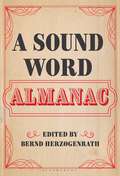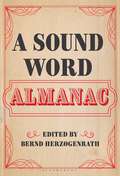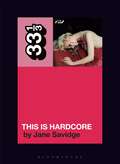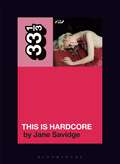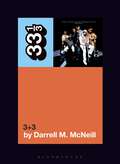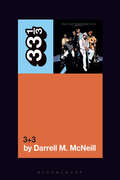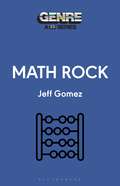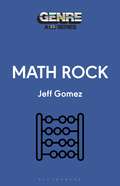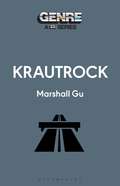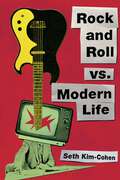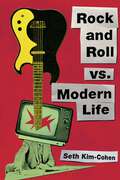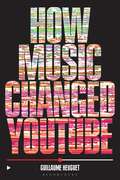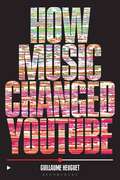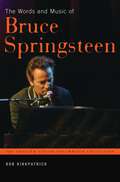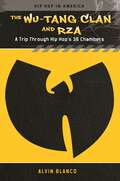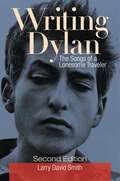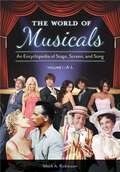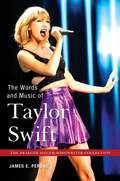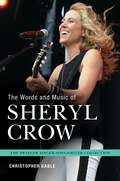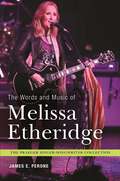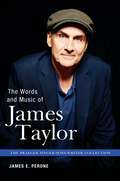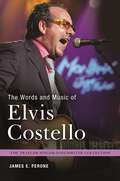- Table View
- List View
A Sound Word Almanac
This almanac of sound words important to artists and scholars highlights words that expand the way we speak (and write) about sonic experiences.Why write about sound, and how? If sonic philosophy is the attempt "to think about sound by philosophical means," then a metaphilosophical debate appears almost immediately on the horizon: What is called for is an understanding about sound and language, but also about the preconditions of musical understanding. What is at stake is the question of language and sound, as well as expanding how we speak about sonic experience.This almanac tackles these questions from artistic, experimental and personal perspectives. An assemblage of nearly 70 practitioners and theoreticians, artists and scholars offer their favorite 'sound word.' These sound words are onomatopoetical, mythological, practical; words of personal importance to the artists and their craft; words from their memory, related to sound. Many entries are not in English – some are untranslatable – and all are accompanied by a personal, explanatory, poetic entry. These are words that have the potential to change our perspective on listening-musicking-thinking.
A Sound Word Almanac
by Bernd HerzogenrathThis almanac of sound words important to artists and scholars highlights words that expand the way we speak (and write) about sonic experiences.Why write about sound, and how? If sonic philosophy is the attempt "to think about sound by philosophical means," then a metaphilosophical debate appears almost immediately on the horizon: What is called for is an understanding about sound and language, but also about the preconditions of musical understanding. What is at stake is the question of language and sound, as well as expanding how we speak about sonic experience.This almanac tackles these questions from artistic, experimental and personal perspectives. An assemblage of nearly 70 practitioners and theoreticians, artists and scholars offer their favorite 'sound word.' These sound words are onomatopoetical, mythological, practical; words of personal importance to the artists and their craft; words from their memory, related to sound. Many entries are not in English – some are untranslatable – and all are accompanied by a personal, explanatory, poetic entry. These are words that have the potential to change our perspective on listening-musicking-thinking.
Pulp's This Is Hardcore (33 1/3)
by Jane SavidgeThis Is Hardcore is Pulp's cry for help. A giant, sprawling, flawed masterpiece of a record, the 1998 album manages to tackle some of the most inappropriate grown-up issues of the day – fame, ageing, mortality, drugs, and pornography – and still come out crying and laughing on the other side. The subject of pornography dominates the record – from its controversial artwork to the images conjured up by songs like "Seductive Barry" and the title track – after Pulp's main man, Jarvis Cocker – who'd spent most of his teenage and adult life chasing celebrity, only to be cruelly disappointed when it finally arrived in spades – hit upon the grand notion of using pornography as a metaphor for fame. The album's commercial failure as a follow-up to the band's Britpop-defining, Different Class, also symbolizes a death knell for Britpop itself. Dark, right? Except just like Pulp themselves, Jane Savidge's book is playful and sometimes very funny indeed. Kicking off with an imaginary conversation between Jarvis Cocker and the people who run the Total Fame Solutions helpline, Savidge expertly guides us through the trials and tribulations of an album that begins with the so-called Michael Jackson Incident, when Cocker got up on stage at the 1996 Brit Awards and waggled his fully-clothed bum at the King of Pop. Pulp's This Is Hardcore may be a sleazy run through porn and mental demise, and an album that chronicles Cocker's continuing disillusionment with his newfound lot in life, but Savidge's book assesses the cultural and historical context of the album with insider knowledge and a sharp modern lens, ultimately making a case for it as one of the most important albums of the 1990s.
Pulp's This Is Hardcore (33 1/3)
by Jane SavidgeThis Is Hardcore is Pulp's cry for help. A giant, sprawling, flawed masterpiece of a record, the 1998 album manages to tackle some of the most inappropriate grown-up issues of the day – fame, ageing, mortality, drugs, and pornography – and still come out crying and laughing on the other side. The subject of pornography dominates the record – from its controversial artwork to the images conjured up by songs like "Seductive Barry" and the title track – after Pulp's main man, Jarvis Cocker – who'd spent most of his teenage and adult life chasing celebrity, only to be cruelly disappointed when it finally arrived in spades – hit upon the grand notion of using pornography as a metaphor for fame. The album's commercial failure as a follow-up to the band's Britpop-defining, Different Class, also symbolizes a death knell for Britpop itself. Dark, right? Except just like Pulp themselves, Jane Savidge's book is playful and sometimes very funny indeed. Kicking off with an imaginary conversation between Jarvis Cocker and the people who run the Total Fame Solutions helpline, Savidge expertly guides us through the trials and tribulations of an album that begins with the so-called Michael Jackson Incident, when Cocker got up on stage at the 1996 Brit Awards and waggled his fully-clothed bum at the King of Pop. Pulp's This Is Hardcore may be a sleazy run through porn and mental demise, and an album that chronicles Cocker's continuing disillusionment with his newfound lot in life, but Savidge's book assesses the cultural and historical context of the album with insider knowledge and a sharp modern lens, ultimately making a case for it as one of the most important albums of the 1990s.
The Isley Brothers' 3+3 (33 1/3)
by Darrell M. McNeillThe Isley Brothers' 3+3, dissects The Isleys' 50-year-old undisputed masterwork, an album that firmly established their music dynasty on a global scale, as well as heralding the boldest run of genre-defiant albums of their 67-year career. The 1973 watershed was their first multiplatinum release and is significant as a rare, crossover record by a Black act that struck a chord with urban, rock, and pop consumers, despite the schisms between audiences due to bias-driven media and industry marketing.The book looks at the album from all angles: from The Isleys' early career to their influence on rock and rollers both Black and White, from the twists and turns of having national hits without national recognition, on to their decision to form T-Neck Records and the group's challenges navigating a music industry that racially codified music and hampered Black artists from universal acclaim and compensations. Finally, a summation of the decades follows The Isleys' run and its ups and downs, with a fast-forward to where the group is now after 67 years.
The Isley Brothers' 3+3 (33 1/3)
by Darrell M. McNeillThe Isley Brothers' 3+3, dissects The Isleys' 50-year-old undisputed masterwork, an album that firmly established their music dynasty on a global scale, as well as heralding the boldest run of genre-defiant albums of their 67-year career. The 1973 watershed was their first multiplatinum release and is significant as a rare, crossover record by a Black act that struck a chord with urban, rock, and pop consumers, despite the schisms between audiences due to bias-driven media and industry marketing.The book looks at the album from all angles: from The Isleys' early career to their influence on rock and rollers both Black and White, from the twists and turns of having national hits without national recognition, on to their decision to form T-Neck Records and the group's challenges navigating a music industry that racially codified music and hampered Black artists from universal acclaim and compensations. Finally, a summation of the decades follows The Isleys' run and its ups and downs, with a fast-forward to where the group is now after 67 years.
Math Rock (Genre: A 33 1/3 Series)
by Jeff GomezMath rock sounds like blueprints look: exact, precise, architectural. This trance-like progressive metal music with indie rock and jazz influences has been captivating and challenging listeners for decades. Bands associated with the genre include King Crimson, Black Flag, Don Caballero, Slint, American Football, Toe, Elephant Gym, Covet, and thousands more. In an online age of bedroom producers and sampled beats and loops, math rock is music that is absolutely and resolutely played: men and woman in rooms with instruments creating chaos, beauty, and beautiful chaos.This is the first book-length look at the global phenomenon. Containing interviews with prominent musicians, producers, and critics spanning the globe, Math Rock will delight longtime fans while also serving as a primer for those who want to delve deeper. It shows why and how an intellectually complex, largely faceless, and almost entirely instrumental form of music has been capturing the attention of listeners for 50 years-and counting.
Math Rock (Genre: A 33 1/3 Series)
by Jeff GomezMath rock sounds like blueprints look: exact, precise, architectural. This trance-like progressive metal music with indie rock and jazz influences has been captivating and challenging listeners for decades. Bands associated with the genre include King Crimson, Black Flag, Don Caballero, Slint, American Football, Toe, Elephant Gym, Covet, and thousands more. In an online age of bedroom producers and sampled beats and loops, math rock is music that is absolutely and resolutely played: men and woman in rooms with instruments creating chaos, beauty, and beautiful chaos.This is the first book-length look at the global phenomenon. Containing interviews with prominent musicians, producers, and critics spanning the globe, Math Rock will delight longtime fans while also serving as a primer for those who want to delve deeper. It shows why and how an intellectually complex, largely faceless, and almost entirely instrumental form of music has been capturing the attention of listeners for 50 years-and counting.
Neue Deutsche Welle (Genre: A 33 1/3 Series)
by Claudia LonkinNeue Deutsche Welle (NDW), or “German New Wave,” was made extraordinarily popular in the 1970s and 1980s by the likes of Nena's "99 Luftballoons" and Trio's "Da Da Da"-and then left as quickly as it came. Conventional wisdom among artists dictates that it's better to burn out than fade away, but this doesn't tell the full story of NDW-the reason for its rapid rise and fall, the historical context that necessitated the genre, and where the energy of the NDW movement went after its end. The genre has international influences but still demonstrates a uniquely German desire to build a new, sanitized identity in the aftermath of World War II. Originally quite subversive and underground, NDW became exponentially more mainstream until it could no longer sustain itself creatively. And rather than disappearing, it helped give rise to the post-Cold War rave craze and is still an important touchstone in music history.
Neue Deutsche Welle (Genre: A 33 1/3 Series)
by Claudia LonkinNeue Deutsche Welle (NDW), or “German New Wave,” was made extraordinarily popular in the 1970s and 1980s by the likes of Nena's "99 Luftballoons" and Trio's "Da Da Da"-and then left as quickly as it came. Conventional wisdom among artists dictates that it's better to burn out than fade away, but this doesn't tell the full story of NDW-the reason for its rapid rise and fall, the historical context that necessitated the genre, and where the energy of the NDW movement went after its end. The genre has international influences but still demonstrates a uniquely German desire to build a new, sanitized identity in the aftermath of World War II. Originally quite subversive and underground, NDW became exponentially more mainstream until it could no longer sustain itself creatively. And rather than disappearing, it helped give rise to the post-Cold War rave craze and is still an important touchstone in music history.
Krautrock (Genre: A 33 1/3 Series)
by Marshall GuKrautrock is not a music genre. Krautrock is a way of life. Its sonic diversity and global reach belie the common culture from where it emerged. This is a band-by-band history. In May 1945, the Allies defeated Nazi Germany, putting an end to the European front of World War II and the Third Reich. In the immediate aftermath, German youth were tasked to create their own culture. Krautrock is this unlikely success story, as hundreds of bands-including Kraftwerk and Can-seemed to sprout overnight in the early 1970s, forging a unique and experimental sound that was different than American or British rock. The major innovation of krautrock is not only its motorik beat, the steady click-click of Can's Jaki Liebezeit or monolithic stomp-stomp of Neu!'s Klaus Dinger, but also how the musicians relate to each other. In krautrock, no musician is given more focus than any other, and listening to these bands is to witness interplay common in jazz music. Thus, krautrock represents German politics reflected in music: a dictatorship replaced by democracy. Krautrock explores the history and methodology of the genre, charting its influences and innovations, its more mainstream acts (like Faust, Kraftwerk, and Can) as well as the less universally known (including Harmonia, Popol Vuh, Embryo, and Ash Ra Tempel), and how the genre developed in post-war Germany and what it means to today's listeners.
Krautrock (Genre: A 33 1/3 Series)
by Marshall GuKrautrock is not a music genre. Krautrock is a way of life. Its sonic diversity and global reach belie the common culture from where it emerged. This is a band-by-band history. In May 1945, the Allies defeated Nazi Germany, putting an end to the European front of World War II and the Third Reich. In the immediate aftermath, German youth were tasked to create their own culture. Krautrock is this unlikely success story, as hundreds of bands-including Kraftwerk and Can-seemed to sprout overnight in the early 1970s, forging a unique and experimental sound that was different than American or British rock. The major innovation of krautrock is not only its motorik beat, the steady click-click of Can's Jaki Liebezeit or monolithic stomp-stomp of Neu!'s Klaus Dinger, but also how the musicians relate to each other. In krautrock, no musician is given more focus than any other, and listening to these bands is to witness interplay common in jazz music. Thus, krautrock represents German politics reflected in music: a dictatorship replaced by democracy. Krautrock explores the history and methodology of the genre, charting its influences and innovations, its more mainstream acts (like Faust, Kraftwerk, and Can) as well as the less universally known (including Harmonia, Popol Vuh, Embryo, and Ash Ra Tempel), and how the genre developed in post-war Germany and what it means to today's listeners.
Rock and Roll Vs. Modern Life
by Seth Kim-CohenNo Boomer-esque celebration of the "music that defined an era," Rock and Roll vs. Modern Life is instead a deeply critical analysis of rock and roll as a chaotic, caterwauling project to upend the foundational presumptions of postwar values. What we have here is the closest thing yet to a unified field theory of rock and roll. In seminal performances, films, and recordings, Iggy Pop, James Brown, Patti Smith, the Last Poets, and the Sex Pistols disrupt the implicit ontologies of modernism and late-stage capitalism. With its comrades, conceptual art, Black power, and poststructuralism, rock and roll strips back the linoleum surface of modern life to reveal a feral sensibility unwilling to be boxed up for clean consumption.
Rock and Roll Vs. Modern Life
by Seth Kim-CohenNo Boomer-esque celebration of the "music that defined an era," Rock and Roll vs. Modern Life is instead a deeply critical analysis of rock and roll as a chaotic, caterwauling project to upend the foundational presumptions of postwar values. What we have here is the closest thing yet to a unified field theory of rock and roll. In seminal performances, films, and recordings, Iggy Pop, James Brown, Patti Smith, the Last Poets, and the Sex Pistols disrupt the implicit ontologies of modernism and late-stage capitalism. With its comrades, conceptual art, Black power, and poststructuralism, rock and roll strips back the linoleum surface of modern life to reveal a feral sensibility unwilling to be boxed up for clean consumption.
How Music Changed YouTube
by Dr. Guillaume HeuguetHow do digital technologies transform music? The answer depends on the lens of one's analysis: creation, promotion, or the experience of the listener. How Music Changed YouTube shows that the reverse question – How does music transform digital technologies? – is also worth exploring: through reliance on sound recording and music, internet technologies and media are manufactured, transformed, and come to dominate.Guillaume Heuguet's study situates YouTube in relation to both the internet platform and music industries by unpacking the cultural and technological forms embedded within and observing the practices and values associated with it, from the art of collecting to the accelerated circulation of samples and remixes. Heuguet's documentary and genealogical work relies on YouTube's traces in internet archives, its successive interfaces, the blogs of its teams, and a few emblematic channels and videos. Particular attention is paid to the tensions between the promises associated with music algorithms - recommendation system, copyright control, view calculation - and the reality of their operation from a technical and cultural point of view. How Music Changed YouTube shows how, far from responding to an immediate need, YouTube's editorial and economic model developed over time, how the various fans, artists, labels, lawyers and legislators shaped the site, and how these factors affected its rise as a global media force in the early 21st century.
How Music Changed YouTube
by Dr. Guillaume HeuguetHow do digital technologies transform music? The answer depends on the lens of one's analysis: creation, promotion, or the experience of the listener. How Music Changed YouTube shows that the reverse question – How does music transform digital technologies? – is also worth exploring: through reliance on sound recording and music, internet technologies and media are manufactured, transformed, and come to dominate.Guillaume Heuguet's study situates YouTube in relation to both the internet platform and music industries by unpacking the cultural and technological forms embedded within and observing the practices and values associated with it, from the art of collecting to the accelerated circulation of samples and remixes. Heuguet's documentary and genealogical work relies on YouTube's traces in internet archives, its successive interfaces, the blogs of its teams, and a few emblematic channels and videos. Particular attention is paid to the tensions between the promises associated with music algorithms - recommendation system, copyright control, view calculation - and the reality of their operation from a technical and cultural point of view. How Music Changed YouTube shows how, far from responding to an immediate need, YouTube's editorial and economic model developed over time, how the various fans, artists, labels, lawyers and legislators shaped the site, and how these factors affected its rise as a global media force in the early 21st century.
The Words and Music of Bruce Springsteen: The Words And Music Of Bruce Springsteen (The Praeger Singer-Songwriter Collection)
by Rob KirkpatrickBruce Springsteen's career has been covered many times over, yet many of the complexities and apparent contradictions of his music remain unresolved. Rob Kirkpatrick provides a comprehensive and coherent look at the work of this thoroughly complex and persistently captivating artist. After a brief biographical treatment, Kirkpatrick considers all of Springsteen's significant albums in chronological order. These include Born to Run, which was voted the most popular album of all time in a recently published Zagat survey; Born in the U.S.A., which sold more than 20 million copies; and The Rising, regarded by many as the most poignant artistic reaction to 9/11. In addition to a probing musical analysis, the book offers a guide to Springsteen's lyrical themes and motifs, allowing readers insight into the complicated nature of the artist's underlying concerns, influences, and ideas. Rounding out the volume is a consideration of The Boss's legacy as a songwriter and musician, as well as appendices including a bibliography and a complete discography.The Words and Music of Bruce Springsteen provides a comprehensive and coherent look at the work of a thoroughly complex and persistently captivating artist. Springsteen enjoys a popularity that has transcended generations. His 1975 album Born to Run was voted the most popular album of all time in a recently published Zagat survey; his 1984 album Born in the U.S.A. spawned seven Top Ten singles while selling more than 20 million copies; and his 2002 album The Rising was regarded by many critics as the most poignant artistic reaction to 9/11. Springsteen, now in his 50s, has evolved from an over-hyped version of the next Bob Dylan, to the future of rock and roll in the mid-1970s, to a pop culture icon in Reagan America, to a 21st-century populist voice. His career has been covered many times over, yet many of the complexities and apparent contradictions of his music remain unresolved. These include his hard-rock influenced musical background; his movement from themes of rebellion and isolation in his early work to those of a more populist complexion later on; and his contribution in the 1980s to a conservative patriotism—despite his albums' close association with the music and ideas of Woody Guthrie.After a brief biographical treatment, Kirkpatrick considers all of Springsteen's significant albums in chronological order. In addition to this probing musical analysis, he offers a guide to Springsteen's lyrical themes and motifs, allowing readers a coherent insight into the complicated nature of the artist's underlying concerns, influences, and ideas. Rounding out the volume is a consideration of The Boss's legacy as a songwriter and musician, as well as appendices including a bibliography and a complete discography. In sum, The Words and Music of Bruce Springsteen provides a comprehensive and coherent look, previously unavailable in a single volume, at the work of a thoroughly complex and persistently captivating artist.
The Wu-Tang Clan and RZA: A Trip through Hip Hop's 36 Chambers (Hip Hop in America)
by Alvin BlancoThis insightful biography looks at the turbulent lives, groundbreaking music and lyrics, and powerful brand of hip hop's infamous Wu-Tang Clan.The Wu-Tang Clan and RZA: A Trip through Hip Hop's 36 Chambers chronicles the rise of the Wu-Tang Clan from an underground supergroup to a globally recognized musical conglomerate. Enhanced by the author's one-on-one interviews with group members, the book covers the entire Wu-Tang Clan catalog of studio albums, as well as albums that were produced or heavily influenced by producer/rapper RZA. Wu-Tang Clan's albums are analyzed and discussed in terms of their artistry as well as in terms of their critical, cultural, and commercial impact. By delving into the motivation behind the creation of pivotal songs and albums and mining their dense metaphor and wordplay, the book provides an understanding of what made a team of nine friends and relatives from Staten Island with a love of Kung Fu movies into not just a music group, but a powerful cultural movement.
Writing Dylan: The Songs of a Lonesome Traveler
by Larry David SmithThis study of Dylan's mission-driven music reveals a functional approach to art that not only sustained his 60-year career but forever changed an art form.The second edition of Writing Dylan: The Songs of a Lonesome Traveler examines Nobel Laureate Bob Dylan's historic career, yielding unique insights into a distinctively American artist's creative world. The book opens with a short biography and description of Dylan's artistic method before diving into the seven missions of his life's work. Chapters are supported by song lyrics, of which the author's license agreement with Bob Dylan Music enables a definitive presentation.Since the release of the first edition in 2005, the laureate has produced three albums of original material as well as three widely praised albums of American standards. Columbia Records has issued multiple boxed sets chronicling specific periods of Dylan's career, and several films have been made about him. Dylan himself has also given numerous speeches and interviews, often while accepting prestigious awards. This second edition not only features these new materials but draws on them to recast the first edition, presenting Dylan's music as an indelible art form.
The World of Musicals [2 volumes]: An Encyclopedia of Stage, Screen, and Song [2 volumes]
by Mark A. RobinsonThis wide-ranging, two-volume encyclopedia of musicals old and new will captivate young fans—and prove invaluable to those contemplating staging a musical production.Written with high school students in mind, The World of Musicals: An Encyclopedia of Stage, Screen, and Song encompasses not only Broadway and film musicals, but also made-for-television musicals, a genre that has been largely ignored. The two volumes cover significant musicals in easily accessible entries that offer both useful information and fun facts. Each entry lists the work's writers, composers, directors, choreographers, and cast, and includes a song list, a synopsis, and descriptions of the original production and important revivals or remakes. Biographical entries share the stories of some of the brightest and most celebrated talents in the business.The encyclopedia will undoubtedly ignite and feed student interest in musical theatre. At the same time, it will prove a wonderful resource for teachers or community theatre directors charged with selecting and producing shows. In fact, anyone interested in theatre, film, television, or music will be fascinated by the work's tantalizing bits of historical and theatre trivia.
The Words and Music of Taylor Swift (The Praeger Singer-Songwriter Collection)
by James E. PeroneThis scholarly analysis of the music of Taylor Swift identifies how and why she is one of the early 21st century's most recognizable and most popular stars.By the age of 13, singer-songwriter Taylor Swift had already inked a development deal with a major record label. This early milestone was an appropriate predictor of what accomplishments were to come. Now a superstar artist with an international fanbase of millions and several critically acclaimed and commercially successful albums, Swift has established herself as one of the most important musicians of the 21st century. This accessible book serves Taylor Swift fans as well as students of contemporary popular music and popular culture, critically examining all of this young artist's work to date.The book's organization is primarily chronological, covering Taylor Swift's album and single releases in order of release date while also documenting the elements of her music and personality that have made her popular with fans of country music and pop music across a surprisingly diverse age range of listeners. The chapters address how Swift's songs have been viewed by some fans as anthems of empowerment or messages of encouragement, particularly by members of the LGBTQ community, those who have been bullied or been seen as outsiders, and emerging artists. The final chapter places Swift's work and her public persona in the context of her times with respect to her use of and relationship with technology—for example, her use of social media and songwriting technology—and her expressions of a new type of feminism that is unlike the feminism of the 1970s.
The Words and Music of Sheryl Crow (The Praeger Singer-Songwriter Collection)
by Christopher GableOffering commentary, musical analysis, and detailed interpretation of her songs' lyrics, this book examines the qualities of Sheryl Crow's music that have served to establish the artist's success and popularity.Sheryl Crow continues to be celebrated for her legacy as a singer-songwriter and pop culture icon. This book provides an introduction to Sheryl Crow's entire music catalog. Organized into chronological periods of time, the author weaves biographical facts throughout a narrative rich with details about her songs: how they were created, recorded, distributed, and modified in live performance. Accompanying commentary features song analysis—including song structure, chord progression, and melody—and provides fascinating insights into the lyrical content of Crow's songwriting. The work begins with Crow's upbringing, her musical roots and influences, and how they manifested themselves in her later career. Subsequent sections delve into her road to success and eventual stardom, revealing how her rise to fame and widespread popularity was littered with broken friendships, acrimony, and suicide. The last several chapters follows her life after a diagnosis of breast cancer and the adoption of her sons. The work also includes a chapter on B-sides and rare songs by Crow.
The Words and Music of Melissa Etheridge (The Praeger Singer-Songwriter Collection)
by James E. PeroneFor a quarter century, Melissa Etheridge has been one of the most iconic and prolific female rock musicians. This book critically examines this songwriter's portrayal of universal human emotions and experiences against the context of her life.Songwriter. Pop star. Gay activist. Cancer survivor. Advocate for cancer victims. Human being. Melissa Etheridge is all of these things, and all of these elements of who she is have played an instrumental role in her music from the beginning of her career to the present day. The Words and Music of Melissa Etheridge examines Melissa Etheridge's contributions to pop music in the tradition of other greats such as Janis Joplin, Bruce Springsteen, and Rod Stewart. Written by a music scholar and Etheridge fan, this book investigates her work chronologically by time period, underscoring her growth as a songwriter and musician and demonstrating how her music reflected the events in her life, both positive and negative.Author James E. Perone spotlights how Etheridge's songs defy traditional gender roles and stereotypes and appeal to general audiences with their universal themes, yet serve those in the lesbian community because of the specific applicability of her words to the members of this minority group. The book supplies expert, critical, and easy-to-understand analysis of all of the songs of Melissa Etheridge's studio albums from the 1980s through to her autobiographical and reflective album, 4th Street Feeling, released in 2012.
The Words and Music of James Taylor (The Praeger Singer-Songwriter Collection)
by James E. PeroneA valuable resource for James Taylor fans and a fascinating read for anyone interested in autobiographical popular music of the past 50 years.What kinds of unusual musical forms and lyrical structures did American singer-songwriter James Taylor incorporate into his songs? What role did Taylor play in the introspective singer-songwriter movement of the 1970s? How did Taylor write and record songs that were inspired from his own experiences in life that touched so many other people? The Words and Music of James Taylor explores these specific topics and provides detailed critical analysis of the songs and recordings of this well-known musical icon, examining his melodic writing, his use of harmony, and his often-unappreciated tailoring of musical form to enhance his lyrical messages. The book is organized chronologically, primarily around Taylor's studio albums from 1968 to 2015, and offers an introduction, a summary of Taylor's career and importance, as well as an annotated bibliography and discography. The final section of the book presents an overview of Taylor's importance and lasting impact, an analysis of themes that run through his songs, and an explanation of how Taylor's treatment of these themes changed over the years as he matured and as the world around him changed.
The Words and Music of Elvis Costello (The Praeger Singer-Songwriter Collection)
by James E. PeroneThis book provides in-depth analysis of the words, music, and recordings of Elvis Costello, one of the most enigmatic, eclectic, and critically acclaimed singer-songwriters of the rock era.Elvis Costello is one of the greatest pop songwriters of his generation as well as one of the most significant songwriters of the 20th century. His career's length now approaching four decades, Costello continues to be vital part of pop culture through live performances, recordings, and the iconic nature of his work. The Words and Music of Elvis Costello provides in-depth analysis of this important artist's words, music, and recordings. Arranged chronologically, the book places Costello in the cultural context of his time and place; addresses the overlaps between rock, classical, torch song, and jazz in Costello's highly eclectic range of songs from 1975 to the present; provides a look at the uniquely British aspects of his work; and uniquely spotlights his compositional techniques and approaches to musical form. The book covers everything from Costello's first album My Aim Is True as well as his other albums in the 1970s to his body of work in the '80s and '90s to his continuing eclecticism in the 21st century as he successfully integrates what would appear to be mutually exclusive genres. The concluding chapter provides analysis of the critical commentary about Elvis Costello's work as a performer and songwriter over his long career.
